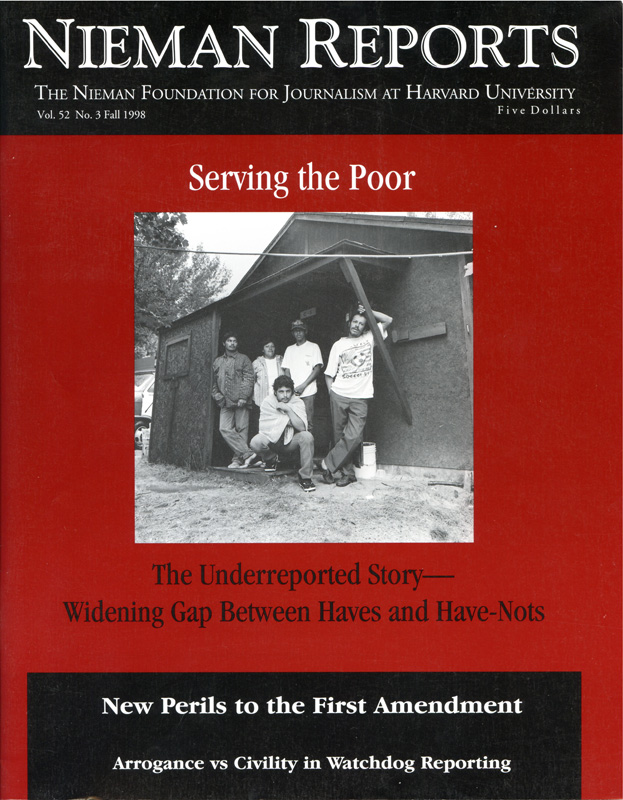I’m not very good at prognostication, although I have had my moments. I predicted in January of 1992 that Bill Clinton would become president. (I have witnesses, I swear.) I predicted that the Denver Broncos would win last year’s Super Bowl. And I predicted that the next big design tool in on-line media sites would be text.
That’s right, text. Words. Not snazzy javascript rollovers, not nifty live video and not dazzling Shockwave multi-media presentations, although all of the above certainly do have their place in a good on-line media site. The proof is in the pudding, so to speak. Witness the recent redesigns of three of the Web’s biggest on-line newspaper sites: The Boston Globe, The New York Times and The Washington Post. All three have abandoned a “Web” look for a “newspaper” one. While avant-garde designers may bemoan this retro-look, it is happening for a very good reason.
It’s what the customer wants. It is elegant, descriptive and easy to download. It shows the “keep it simple, stupid” principle works as well in the virtual world as it does in the real one.
There are some good reasons why text has become the “design” choice du jour, and will probably remain so for a while:
a) Bandwidth problems—For all the talk about better connectivity and faster download speeds, most people still use a 28.8 modem to access the Net. For them, text is a real godsend.
b) Demographics—A survey done by Find/SVP in 1996 showed that the age group that uses news the most, 30-50, is also the group with the least amount of time to spend on line. They want news presented to them in a fast and easy-to-understand format and again, text gives them what they want.
c) As Popeye would say, “I y’am, what I y’am, and that’s what I y’am.” You might call this the perception factor. The New York Times, The Boston Globe, The Washington Post and The Christian Science Monitor are on-line “newspapers,” and that is exactly how on-line readers see us. As newspapers. True, they appreciate all the cool things the Web offers, like access to archives, personalization, and the interactive tools mentioned above, but they still see us as newspapers. And they like the way newspapers look and organize information.
At this point, I want to refer to my own experience with The Christian Science Monitor’s electronic edition as further proof of both my “text has triumphed” thesis and the perception factor of on-line newspapers.
Several months ago we decided to drastically change the way we presented the daily on-line edition of the paper. Working with a company in York, England, called Infosis, we developed an on-line version of the “real” paper. Rather than using the menu/contents format that sites like The New York Times or The Post uses, we created a graphical representation of each page of the newspaper in a left-hand frame.
When a reader wants to read a story on page five, for example, he or she simply clicks on that story image and it appears in the right-hand frame, replete with all the wonders of the Web like extra information links, javascript-powered maps, etc.
We were, of course, worried that we would be sacrificed at the altar of the design gods for this blasphemy, and truth be told, some people didn’t like the idea when they heard about it and haven’t changed their minds now that they’ve seen it.
But lots of people did like it. In fact, the page views in the “Today’s Paper” section of the site went up by 35 percent, because people were reading the on-line edition the same way they read a regular paper. Rather than hunting around to find their favorite columnist or feature, they could find it in the same place in the on-line edition as in the print version. Also, our readers were “thumbing” through the on-line edition, looking at page after page, finding stories they liked.
The Infosis version does rely on simple graphics, but graphics presented in a “text format.” And for people who didn’t want to browse the paper, we added a contents menu that allows them to see all of the stories in the left-hand frame and read them in the right one.
Personally, I don’t believe this is a step backwards. It’s a step to acknowledge the realities of the Web and of people’s lives. Our main purpose is to inform people. On-line media also allows us to present them with choices that they would never have in newsprint versions. And while it is true that this new medium will allow us to present these choices in ever more interactive and useful ways, we must always be careful not to be seduced by “the dark side of the Web.” Futuristic sites such as “Word” were fun to visit once or twice just to see what new wrinkle they had created, but if you wanted to read a story or find information, it was no easy chore—probably the reasons many of these sites are defunct.
One day, these futuristic designs will rule the Web and online media. But the reality is that we’re living in the here and now, not the future, and the people who read our on-line sites today want their news presented to them in a pretty simple format. Yes, it might be boring and retro. But it gets the job done and keeps the customers happy. And that is really what it is all about.
Tom Regan is the Associate Editor of The Christian Science Monitor’s electronic edition.



